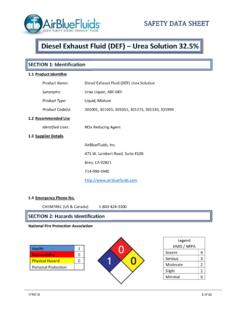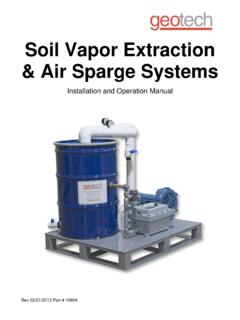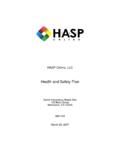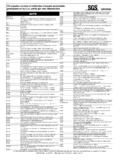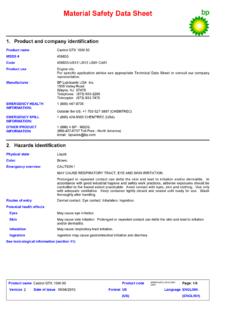Transcription of SAFETY DATA SHEET - Airbluefluids
1 SAFETY data SHEET . SECTION 1: Identification Product Identifier Product Name: Diesel Exhaust Fluid (DEF) Urea Solution Synonyms: Urea Liquor, ABF-DEF. Product Type: Liquid, Mixture Product Code(s): 301001, 301025, 301055, 301275, 301330, 301999. Recommended Use Identified Uses: NOx Reducing Agent Supplier Details Airbluefluids , Inc. 471 W. Lambert Road, Suite #100. Brea, CA 92821. 714-990-3940. Emergency Phone No. CHEMTREC (US & Canada) 1-800-424-9300. SECTION 2: Hazards Identification National Fire Protection Association Legend HMIS / NFPA. Health 1. Severe 4. Flammability 0. Serious 3. Physical Hazard 0. Moderate 2. Personal Protection Slight 1. Minimal 0. 5/27/15 1 of 11. SAFETY data SHEET Diesel Exhaust Fluid, Urea Solution (DEF). Classification of the Substance or mixture This material is not classified as hazardous. Label Elements Signal Word: None Hazard Statement: No labeling applicable Pictograms: None Precautionary Statements: P302+P352 IF ON SKIN: Wash with plenty soap and water.
2 P305+P351 IF IN EYES: Rinse cautiously with water for several minutes. P332+P313 If skin irritation occurs: get medical advice/attention. P337+P313 If eye irritation persists: get medical advice/attention. Other Hazards Eye: Contact may cause mild eye irritation including stinging, watering, and redness. Skin: Contact may cause mild skin irritation including redness and burning. No harmful effects from skin absorption have been reported. Inhalation (Breathing): No information available. Studies by other exposure routes suggest a low degree of toxicity by inhalation. Ingestion (Swallowing): No information available. Studies by other exposure routes suggest a low degree of toxicity by inhalation. Signs and Symptoms: Effects of overexposure may include irritation of the nose, throat and digestive tract, headaches, coughing, nausea, vomiting, and transient disorientation. Cancer: Inadequate evidence available to evaluate the cancer hazard of this material. SECTION 3: Composition / Information of Ingredients Name Product Identifier % by weight GHS- US Classification Urea (CAS No.)
3 57-13-6 31 - 33 Not Classified Water (CAS No.) 7732-18-5 67 -69 Not Classified 5/27/15 2 of 11. SAFETY data SHEET Diesel Exhaust Fluid, Urea Solution (DEF). SECTION 4: First Aid Measures Description of Necessary First Aid Measures General: If medical attention is needed have product container or label available. Eye Contact: If irritation or redness develops, move victim away from exposure and into fresh air. Flush eyes with clean water. If symptoms persist, seek medical attention. Skin Contact: Remove contaminated shoes and clothing and cleanse affected area(s). thoroughly by washing with mild soap and water. If irritation or redness develops and persists, seek medical attention. Wash contaminated clothing before reuse. Inhalation: If respiratory problems develop, move victim away from source of exposure and into fresh air. If symptoms persist, seek medical attention. If victim is not breathing, clear airway and immediately begin artificial respiration. If breathing difficulties develop, oxygen should be administered by qualified personnel.
4 Seek immediate medical attention. Ingestion: First aid is not normally required; however, if swallowed and symptoms develop, seek medical attention. Most Important symptoms and effects, both acute and delayed Eye Contact: Contact may cause mild eye irritation including stinging, watering, and redness. Skin Contact: Contact may cause mild skin irritation including redness and burning. No harmful effects from skin absorption have been reported. Inhalation: No information available. Studies by other exposure routes suggest a low degree of toxicity by inhalation. Ingestion: No information available. Studies by other exposure routes suggest a low degree of toxicity by inhalation. Ingesting large quantities may result in abdominal pains, diarrhea, nausea or vomiting. Indication of any immediate medical attention and special treatment needed Notes to physician: No special requirements. Treat symptomatically. SECTION 5: Fire-Fighting Measures Extinguishing Media Suitable Extinguishing Media: Material is non-flammable.
5 Use extinguishing media appropriate for the surrounding fire. Unsuitable Extinguishing Media: None known 5/27/15 3 of 11. SAFETY data SHEET Diesel Exhaust Fluid, Urea Solution (DEF). Special hazards arising from the substance or mixture Fire Hazard: Under fire conditions this material may decompose to ammonia, nitrogen oxides and carbon dioxide. Explosion Hazard: Avoid contact with strong oxidizing agents such as chlorine (bleach), peroxides, chromates, nitric acid, perchlorates, concentrated oxygen or permanganates. Contact can generate heat, fires, explosions and release toxic fumes. Advice for fire-fighters Special Protective Equipment: Fire-fighters should wear complete protective clothing including self-contained breathing apparatus. SECTION 6: Accidental Release Measures Personal precautions, protective equipment and emergency procedures Keep unnecessary personnel away from the spill. Wear appropriate protective equipment including respiratory protection as conditions warrant.
6 Stop the source of the release if it can be done without risk. Immediately isolate the hazard area and restrict access to authorized personnel only. Environmental precautions To prevent spilled material from entering sewers, storm drains or natural watercourses, contain material with a dike or with appropriate absorbent materials such as sand, clay, soil or commercially available absorbent. Inform appropriate authorities if the material enters environmentally sensitive waterways. Prevent material from entering basements or confined areas. Methods and material for containment and clean up Small Spill: Contain any spill with a dike or with appropriate absorbent materials such as sand, clay, soil or commercially available absorbent. Dilute with water and mop up. Place liquid and absorbent into a suitable waste container for disposal at an appropriate disposal facility according to current applicable laws and regulations. Large Spill: Stop the source of the release if it can be done without risk.
7 Immediately isolate the hazard area and restrict access to authorized personnel only. Wear appropriate protective equipment including respiratory protection as conditions warrant. To prevent spilled material from entering sewers, storm drains or natural watercourses, contain material with a dike or with appropriate absorbent materials. Place liquid and absorbent into a suitable waste container for disposal at an appropriate disposal facility according to current applicable laws and regulations. Do not return spilled material to the original containers for re-use. 5/27/15 4 of 11. SAFETY data SHEET Diesel Exhaust Fluid, Urea Solution (DEF). Reference to other sections Personal Protection Section 8. Disposal Considerations Section 13. SECTION 7: Handling and Storage Precautions for safe handling Handle using good industrial hygiene and SAFETY procedures. Wear appropriate personal protective equipment. Avoid breathing vapor or mist. Do not eat, drink or smoke when working with this material.
8 Avoid contact with skin and eyes. Wash hands and other areas of contact thoroughly with soap and water after handling this material. Conditions for safe storage, including and incompatibilities Store material in the original container protected from direct sunlight in a clean, cool, dry and well ventilated area. Avoid containers, piping or fittings made of brass, bronze, all copper alloys, aluminum or galvanized metal. Store this material in closed containers away from incompatible materials (Section 10). Previously opened containers should carefully resealed and stored upright to avoid leaking. Specific end use(s). Industrial applications, emission control, diesel exhaust treatment reagent SECTION 8: Exposure Controls / Personal Protection Control parameters No exposure limits established. Exposure controls Engineering controls: Provide adequate ventilation in storage and handling areas. 5/27/15 5 of 11. SAFETY data SHEET Diesel Exhaust Fluid, Urea Solution (DEF).
9 Individual protection measures Personal protective equipment: Gloves, SAFETY Goggles, Protective Clothing Hand Protection: Impermeable protective gloves should be worn at all times when handling chemical products. Eye protection: Wear close fitting chemical goggles of full face shield where splashing or contact is likely. Do not wear contact lenses. Skin and Body protection: Wear task appropriate protective clothing and full protective suit if splashing may occur. Respiratory protection: Under normal operating conditions no personal respiratory protection is necessary. Use a NIOSH-approved respirator if concentrations of mist or vapor are expected to exceed occupational exposure limits. General Hygiene measures: -Wash contaminated clothing before reuse. -Wash hands after handling the material particularly before eating or drinking. -Avoid breathing mists or vapors. SECTION 9: Physical and Chemical Properties Information on basic physical and chemical properties Physical State : Liquid Appearance : Clear Color : Colorless Odor : Slight, Ammonia pH : ~10.
10 Molecular Weight : (100% Urea). Melting / Freezing point : C ( F). Boiling Point : ~104 C (219 F). Flash Point : No data available Evaporation Rate : No data available Self-ignition temperature : No data available Decomposition temperature : No data available Flammability : No data available 5/27/15 6 of 11. SAFETY data SHEET Diesel Exhaust Fluid, Urea Solution (DEF). Flammability limits : No data available vapor Pressure @ 20 C : 80 Pa @ 20 C. Relative vapor density @ 20 C : No data available Specific Gravity : @ 20 C. Density : lb / gal Solubility : Water: Miscible Viscosity, dynamic : @ 20 C ( F). Explosive properties : No data available Oxidizing Properties : No data available Explosive limits : No data available SECTION 10: Stability and Reactivity Reactivity Material is stable under normal conditions of storage and handling. Chemical Stability Material is stable at standard temperature and pressure. Possibility of hazardous reactions Hazardous polymerization will not occur.
